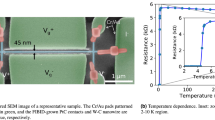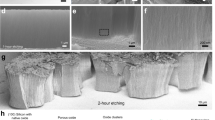Abstract
Several hundred million volts per centimetre of electric-field strength are required to field-ionize gas species. Such fields are produced on sharp metallic tips under a bias of a few kilovolts. Here, we show that field ionization is possible at dramatically lower fields on semiconductor nanomaterials containing surface states, particularly with metal-catalysed whiskers grown on silicon nanowires. The low-voltage field-ionization phenomena observed here cannot be explained solely on the basis of the large field-amplification effect of suspended gold nanoparticles present on the whisker tips. We postulate that field penetration causes upward band-bending at the surface of exposed silicon containing surface states in the vicinity of the catalyst. Band-bending enables the valence electron to tunnel into the surface states at reduced fields. This work provides a basis for development of low-voltage ionization sensors. Although demonstrated on silicon, low-voltage field ionization can be detected on any sharp semiconductor tip containing proper surface states.
This is a preview of subscription content, access via your institution
Access options
Subscribe to this journal
Receive 12 print issues and online access
$259.00 per year
only $21.58 per issue
Buy this article
- Purchase on Springer Link
- Instant access to full article PDF
Prices may be subject to local taxes which are calculated during checkout





Similar content being viewed by others
Change history
01 February 2011
In the version of this Article originally published, the corresponding author and the Acknowledgements were incorrect. These errors have now been corrected in the HTML and PDF versions of the text.
References
Li, F., Xie, Z., Schmidt, H., Sielemann, S. & Baumbach, J. I. Ion mobility spectrometer for online monitoring of trace compounds. Spectrochim. Acta B 57, 1563–1574 (2002).
Riley, D. J. et al. Helium detection via field ionization from carbon nanotubes. Nano Lett. 3, 1455–1458 (2003).
Modi, A., Koratkar, N., Lass, E., Wei, B. & Ajayan, P. M. Miniaturized gas ionization sensors using carbon nanotubes. Nature 424, 171–174 (2003).
Velasquez-Garcia, L. F. & Akinwande, A. I. Micro Electro Mechanical Systems. IEEE 21st International Conference on, 2008, 742–745 (2008).
Gomer, R. Field Emission and Field Ionization (Harvard Univ. Press, 1961).
Miller, M. K., Cerezo, A., Hetherington, M. G. & Smith, G. D. W. Atom Probe Field Ion Microscopy (Oxford University Press, 1996).
Liu, X. & Orloff, J. Analytical model of a gas phase field ionization source. J. Vac. Sci. Technol. B 23, 2816–2820 (2005).
Doerk, G. S., Ferralis, N., Carraro, C. & Maboudian, R. Growth of branching Si nanowires seeded by Au–Si surface migration. J. Mater. Chem. 18, 5376–5381 (2008).
Müller, E. W. & Tsong, T. T. Field Ion Microscopy; Principles and Applications (American Elsevier Pub., 1969).
Forbes, R. G., Edgcombe, C. J. & Valdre, U. Some comments on models for field enhancement. Ultramicroscopy 95, 57–65 (2003).
Read, F. H. & Bowring, N. J. Field enhancement factors of random arrays of carbon nanotubes. Nucl. Instrum. Methods Phys. Res. 519, 305–314 (2004).
Banan-Sadeghian, R. & Kahrizi, M. COMSOL Multiphysics Conf. 251–254 (2005).
Willardson, R. K. & Beer, A. C. Semiconductors and Semimetals: Injection Phenomena (Academic, 1970).
Ohno, Y., Nakamura, S. & Kuroda, T. Mechanisms of field ionization and field evaporation on semiconductor surfaces. Jpn. J. Appl. Phys. 17, 2013–2022 (1978).
Banan-Sadeghian, R. & Kahrizi, M. A novel gas sensor based on tunneling-field-ionization on whisker-covered gold nanowires. IEEE Sensors J. 8, 161–169 (2008).
Singh, J. P., Karabacak, T., Lu, T. M., Wang, G. C. & Koratkar, N. Field ionization of argon using β-phase W nanorods. Appl. Phys. Lett. 85, 3226–3228 (2004).
Garnett, E. C. et al. Dopant profiling and surface analysis of silicon nanowires using capacitance–voltage measurements. Nature Nanotech. 4, 311–314 (2009).
Ohno, Y., Nakamura, S., Adachi, T. & Kuroda, T. Field-ion microscopy of GaAs and GaP. Surf. Sci. 69, 521–532 (1977).
Gao, K., Yan, M., Feng, M. & Zhu, X. Measurement of charge-transfer rate coefficients between Co3+ and Ar, N2 at electron-volt energy. J. Phys. B 35, 233–240 (2002).
Orloff, J. H. & Swanson, L. W. Study of a field-ionization source for microprobe applications. J. Vac. Sci. Technol. 12, 1209–1213 (1975).
Ernst, L. & Block, J. H. Field ion microscopy of germanium: Field ionization and surface states. Surf. Sci. 49, 293–309 (1975).
Müller, E. W. & Bahadur, K. Field ionization of gases at a metal surface and the resolution of the field ion microscope. Phys. Rev. 102, 624–634 (1956).
Moh’d, R., Jason, P. & Robert, W. Tungsten nanotip fabrication by spatially controlled field-assisted reaction with nitrogen. J. Chem. Phys. 124, 204716 (2006).
Acknowledgements
The work reported herein was partially supported by the Natural Sciences and Engineering Research Council (NSERC) of Canada, a University of California CITRIS research grant funded by Hewlett Packard Labs, NSF grant 0547679 and an Army Research Office (ARO) research grant 55176-EL-DRP. R.B.S. would like to thank J. Y. Oh for help with nanowire synthesis, Logeeswaran VJ for help with the vacuum chamber set-up and A. Ghogha for help with statistical analysis.
Author information
Authors and Affiliations
Contributions
R.B.S. designed and carried out experiments, analysed data and wrote the manuscript. M.S.I. supervised the project, analysed data and edited the manuscript. Both authors discussed the results, and commented on the manuscript.
Corresponding author
Ethics declarations
Competing interests
The authors declare no competing financial interests.
Supplementary information
Supplementary Information
Supplementary Information (PDF 1822 kb)
Rights and permissions
About this article
Cite this article
Banan Sadeghian, R., Saif Islam, M. Ultralow-voltage field-ionization discharge on whiskered silicon nanowires for gas-sensing applications. Nature Mater 10, 135–140 (2011). https://doi.org/10.1038/nmat2944
Received:
Accepted:
Published:
Issue Date:
DOI: https://doi.org/10.1038/nmat2944
This article is cited by
-
Design and tailoring of patterned ZnO nanostructures for energy conversion applications
Science China Materials (2017)
-
ZnO Nanowire-Based Corona Discharge Devices Operated Under Hundreds of Volts
Nanoscale Research Letters (2016)
-
An ultrabright and monochromatic electron point source made of a LaB6 nanowire
Nature Nanotechnology (2016)
-
Field-Induced Crystalline-to-Amorphous Phase Transformation on the Si Nano-Apex and the Achieving of Highly Reliable Si Nano-Cathodes
Scientific Reports (2015)
-
Silica nanowires: Growth, integration, and sensing applications
Microchimica Acta (2014)



